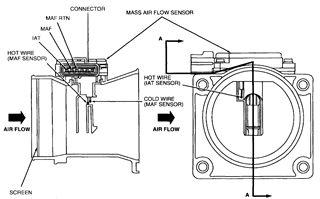Mass Air Flow (MAF) Sensor
The Mass Air Flow (MAF) sensor directly measures the amount of air flowing into the engine. The sensor is mounted between the air cleaner assembly and the air cleaner outlet tube.
The sensor utilizes a hot wire sensing element to measure the amount of air entering the engine. The sensor does this by sending a signal, which is generated by the sensor when the incoming air cools the hot wire, to the PCM. The signal is used by the PCM to calculate the injector pulse width, which controls the air/fuel ratio in the engine.
MAF Sensor
Mass Airflow (MAF) sensors measure the weight and rate of air moving through a passage of a known volume or size. Typically, MAF sensors utilize hot wire or thick film technology. Signals generated may be analog or digital depending on manufacturer. As more air passes through the MAF sensor, the voltage or frequency increases proportionally. The PCM uses this information to calculate injector pulse-width and spark advance. Performance issues from MAF sensor failures range from no-start conditions to stalling, hesitation, stumble and improper air/fuel mixtures. The MAF sensor values vary from 0.2V (0 gm/sec) to 4.8V (175 gm/sec).
Some manufacturers incorporate the Intake Air Temperature (IAT) sensor as part of the Mass Air Flow (MAF) sensor (Air Flow Meter).
Some manufacturers incorporate a 6.0V to 9.0V circuit from the MAF sensor to the PCM to control the MAF sensor reset signal.



